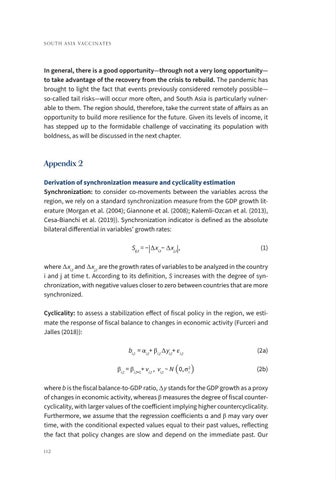S O U T H A S I A VA C C I N A T E S
In general, there is a good opportunity—through not a very long opportunity— to take advantage of the recovery from the crisis to rebuild. The pandemic has brought to light the fact that events previously considered remotely possible— so-called tail risks—will occur more often, and South Asia is particularly vulnerable to them. The region should, therefore, take the current state of affairs as an opportunity to build more resilience for the future. Given its levels of income, it has stepped up to the formidable challenge of vaccinating its population with boldness, as will be discussed in the next chapter.
Appendix 2 Derivation of synchronization measure and cyclicality estimation Synchronization: to consider co-movements between the variables across the region, we rely on a standard synchronization measure from the GDP growth literature (Morgan et al. (2004); Giannone et al. (2008); Kalemli-Ozcan et al. (2013), Cesa-Bianchi et al. (2019)). Synchronization indicator is defined as the absolute bilateral differential in variables’ growth rates: Sij,t = − |∆ xi,t − ∆ xj,t |,
(1)
where ∆ xi,t and ∆ xj,t are the growth rates of variables to be analyzed in the country i and j at time t. According to its definition, S increases with the degree of synchronization, with negative values closer to zero between countries that are more synchronized. Cyclicality: to assess a stabilization effect of fiscal policy in the region, we estimate the response of fiscal balance to changes in economic activity (Furceri and Jalles (2018)): bi,t = α i,t+ β i,t ∆ yi,t + ε i,t
(2a)
β i,t = β i,t−1+ vi,t , vi,t ~ N (0, σ 2i )
(2b)
where b is the fiscal balance-to-GDP ratio, ∆ ystands for the GDP growth as a proxy of changes in economic activity, whereas βmeasures the degree of fiscal countercyclicality, with larger values of the coefficient implying higher countercyclicality. Furthermore, we assume that the regression coefficients α and βmay vary over time, with the conditional expected values equal to their past values, reflecting the fact that policy changes are slow and depend on the immediate past. Our 112




